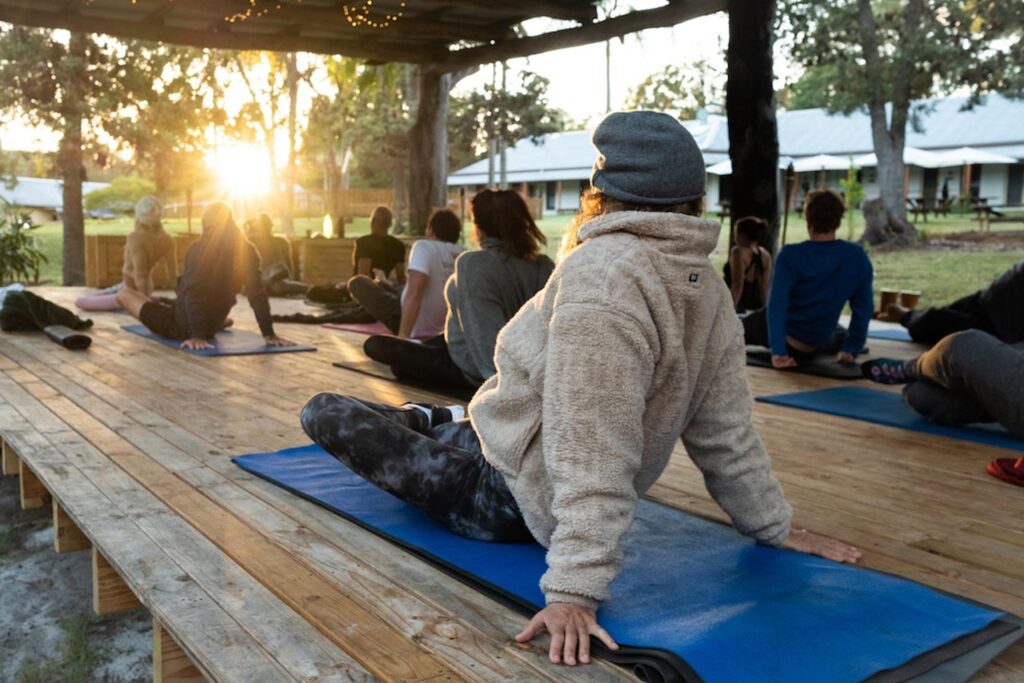Starting a meditation routine can feel a bit mysterious at first, but it’s really just about finding a few quiet moments to sit and breathe. For beginners, the idea of sitting still might seem odd or even a little boring, yet many quickly notice a surprising sense of calm. There’s no need for fancy cushions or incense—just a comfortable spot and an open mind. But what actually happens when someone begins this expedition?
Understanding What Meditation Is
So, what exactly is meditation? Meditation is an ancient practice where people intentionally direct their attention, often settling into a comfortable spot and focusing on their breath, bodily sensations, or mental imagery. The main goal isn’t to stop thoughts altogether but to cultivate mindfulness, noticing each thought as it comes and gently bringing focus back when the mind wanders. Techniques vary—some are silent, others guided, or focused on relaxation and kindness. Over time, these methods help build stronger focus, a sense of mental calm, and greater relaxation. It’s a welcoming practice, open to anyone looking for a supportive mental reset. For those seeking a serene environment to enhance their meditation practice, the Quiet Mind Mountain Lodge offers a lakeside wellness retreat in Southern California focused on relaxation and inner peace.
Exploring the Benefits of Meditation
Often, meditation is celebrated for its powerful impact on both the mind and body, and these benefits go well beyond just feeling a little more relaxed. For anyone looking to feel more connected and supported, understanding how meditation helps can be inspiring.
Practicing regularly can create real, noticeable changes that ripple through daily life. Here are some highlights:
- Noticeable stress reduction, cutting tension by up to 30% in just a month
- Enhanced emotional regulation, helping to manage feelings with greater ease
- Sharper focus and concentration, making everyday tasks smoother
- Improved sleep quality and longer, more restful nights
- Positive brain changes, including increased gray matter for learning and memory
Meditation can also help cultivate a sense of relaxed sophistication by promoting a calm and balanced state of mind, similar to the ambiance experienced at luxury retreats like Auberge du Soleil.
Choosing the Best Time to Meditate
When is the perfect moment to sit down and meditate? The answer isn’t one-size-fits-all. Many beginners discover that morning sessions help start their day with calm and focus, weaving meditation seamlessly into their routine.
Others prefer evenings, using meditation for relaxation after a busy schedule. Some find a midday break, like lunch or mid-afternoon, gives a revitalizing mental reset.
Consistency is what matters most—meditating at the same time every day makes it easier to build the habit. By experimenting with different times, everyone can find a rhythm that fits their lifestyle and helps them feel connected and supported. For those interested in combining meditation with other wellness practices, Sensei Porcupine Creek offers a premier environment focused on personalized wellbeing journeys guided by trained professionals.
Selecting a Comfortable Meditation Space
After figuring out the best time to meditate, it helps to think about where to actually sit down and practice. Creating a comfortable space makes meditation feel inviting and helps enhance focus.
The environment should be peaceful, encouraging a sense of belonging every time you return. A quiet environment without clutter or noise helps you relax and maintain good posture, while details like airflow and lighting set the mood.
Consider these tips when picking your spot:
- Choose a quiet environment with minimal distractions
- Use a chair, cushion, or sofa for comfortable posture
- Keep the space tidy and clutter-free
- Select good airflow and natural light
- Designate the area as your meditation environment
For those seeking a nature immersion experience, consider meditating outdoors or near a window with a view of nature, which can further enhance mindfulness.
Deciding How Long to Meditate
When starting out with meditation, it’s best to keep things short and simple, aiming for just five minutes each day to make the habit stick without adding pressure.
As comfort grows, adding a minute or two each week helps build up endurance, making longer sessions feel much more doable.
The real key is showing up daily, since regular practice does far more for your mind than trying to squeeze in one long session here and there.
Starting With Short Sessions
How long should a beginner actually meditate? For most, starting with short sessions—just 2 to 5 minutes a day—makes the meditation time easy to fit into any daily routine. This approach feels welcoming, especially for a beginner who might worry about sitting still for too long.
The focus is on quality over quantity, creating room for everyone to belong without pressure. Even brief, consistent practice brings benefits.
- Short sessions reduce overwhelm and promote consistency
- Daily routine builds a solid meditation habit
- Even a few minutes can sharpen focus and relieve stress
- Encourages beginners to gradually increase meditation time
- Prevents burnout
Gradually Increasing Duration
Since sitting still for long periods can feel intimidating at first, beginners often wonder how to know when it’s time to meditate longer. The answer is to gradually increase meditate time—start with just 2 to 5 minutes per session. This helps build the habit without pressure.
Each week, add 2 minutes if comfortable, letting progress feel natural rather rather than forced. By the second month, many people reach 10 minutes daily, which deepens the experience.
Consistent practice matters most, so celebrate every step. Remember, everyone’s expedition is different; listen to your body and mind as you find a rhythm that fits you.
Prioritizing Daily Consistency
A key ingredient in building a solid meditation habit is daily consistency, not marathon-length sessions. For beginners, it’s helpful to focus on manageable, regular practice rather than aiming for long sessions that can feel intimidating. Creating a sustainable routine is about showing up each day, even for just a few minutes.
Try to build your sense of belonging to the routine by making meditation a non-negotiable part of your day. Consider these tips:
- Start with 2–5 minutes daily
- Gradually increase by two-minute steps
- Target 10 minutes for noticeable benefits
- Set a specific, manageable duration
- Celebrate each day’s regular practice
Simple Meditation Techniques for Beginners
Getting started with meditation doesn’t have to be complicated—there are plenty of simple techniques that anyone can try, even on a busy day. Beginners often find breath counting helpful, simply inhaling and exhaling while counting from one to ten to anchor attention.
Guided meditations are great for those who appreciate clear direction, often lasting just five to ten minutes.
A body scan invites gentle awareness through the body, one area at a time.
Mantra meditation uses a calming word or phrase, while visualizations, like picturing a peaceful beach, help bring a sense of belonging and relaxation to the experience.
Getting Started With Breath Awareness
One of the easiest ways to begin meditating is by paying attention to the breath, which acts as a steady anchor when the mind feels scattered. Breath awareness invites a sense of calm and connection, especially for newcomers.
To get started, simply notice each inhale and exhale without trying to change anything. As you focus, distractions might pop up, but that’s perfectly normal. Just gently bring your attention back to your breath.
Here are some steps:
- Observe the natural rhythm of your breath
- Feel air at your nostrils or chest rising and falling
- Count each breath cycle
- Restart counting if your mind wanders
- Practice daily for a few minutes
Managing Wandering Thoughts
Ever notice how the mind seems to wander off at the most unexpected moments during meditation? Wandering thoughts are completely normal—everyone experiences them, especially when starting out. Instead of feeling frustrated, it helps to practice a little patience and mindfulness.
When attention drifts, gently redirect focus back to your breath or mantra, almost like guiding a friendly puppy home. Each time this happens, recognize the distraction without judgment, even smile at it, and return to your anchor.
This simple act strengthens the ability to focus attention and builds resilience, making meditation feel more welcoming and effective for everyone involved.
Building Consistency and Forming the Habit
As thoughts wander and the mind learns to return to its anchor, another common challenge pops up—turning meditation into a regular part of daily life. Building consistency doesn’t have to be tough; it’s about crafting a routine that fits, so meditation feels like a natural habit, not a chore.
Research suggests it takes about two months of daily practice to truly stick. Here are some helpful tips:
- Set a regular time, like morning or bedtime, for your practice.
- Start small—just 2-5 minutes.
- Use cues or app notifications.
- Track your progress.
- Celebrate small wins to reinforce your commitment.
Overcoming Common Challenges
Why do so many people find meditation tricky at first? It’s common for wandering thoughts to pop up, making it tough to focus. Beginners might also feel physical discomfort or impatience, questioning their motivation.
The secret is consistency—showing up regularly, even if just for five minutes, helps meditation feel less overwhelming. Self-compassion is essential; everyone gets distracted, so there’s no need for harsh self-judgment.
Adjusting positions or taking breaks can ease discomfort, too. Remember, nobody’s meditation session is perfect. Celebrating effort rather than perfection creates a sense of belonging, making it easier to stick with the practice over time.
Using Tools and Apps for Support
For beginners, meditation apps like Headspace, Calm, and Insight Timer can make things a lot easier by offering guided sessions that fit any schedule. These apps often come with handy features such as prompts and progress tracking, which help users build a steady routine and see how far they’ve come.
Guided meditations also take the guesswork out of technique, so anyone can feel more confident and relaxed as they practice.
Popular Meditation App Options
Ever wondered how technology can make starting meditation a bit easier? For those seeking a sense of community and support, meditation apps are a great way to begin. These beginner-friendly tools offer guided sessions and features that foster consistency and growth.
Some popular choices include:
- Headspace: Known for its “Basics” course, perfect for newcomers.
- Calm: Offers themed meditations for sleep, stress, and focus.
- Insight Timer: Vast free library from diverse teachers.
- Customizable reminders: Apps nudge users to meditate regularly.
- Progress tracking: Visual charts help users see their journey and celebrate milestones.
Meditation apps truly help newcomers feel connected.
Guided Session Benefits
Countless beginners find meditation a bit intimidating at first, but guided sessions through apps like Headspace or Calm help make the experience much smoother. These guided meditation tools offer step-by-step audio, visual cues, and timers, which make consistency much easier to achieve.
For those just starting out, having structure means less guesswork and more focus, reducing stress and confusion. Beginners also benefit from a sense of accountability, as guided sessions encourage regular practice.
With themes like stress reduction or sleep, these guided meditations meet people where they are. Over time, they help users feel supported, connected, and confident in their expedition.
Reminders and Progress Tracking
One clever way beginners can stay on track with meditation is by taking advantage of prompts and progress tracking features found in popular apps like Headspace or Calm. These meditation apps offer helpful cues, making it easier to build consistency and turn meditation into a daily habit.
Progress tracking lets users see their growth and motivates them to keep going. For those who love a little visual encouragement, these tools can make a big difference in habit formation:
- Set daily reminders or notifications for meditation sessions
- Use progress charts and streak trackers
- Log session duration and frequency
- Try habit-tracking journals
- Celebrate milestones for added motivation
Incorporating Meditation Into Daily Life
How can meditation become a natural part of daily life, rather than just another item on a to-do list? It helps to meditate at a consistent time—maybe right after waking up or during a lunch break—to build a steady daily routine.
Starting with short sessions makes the practice feel more inviting, especially for beginners. Gentle cues, like alarms or sticky notes, can reinforce consistency.
Pairing meditation with familiar habits—such as brushing teeth or bedtime—makes it easier to remember. Exploring different environments, whether at home, the office, or outside, helps make mindfulness feel like a regular, welcomed part of everyday life.
Resources for Further Practice and Growth
For those just starting out or looking to deepen their meditation practice, a wide range of helpful resources is available both online and in local communities. Guided meditation apps, like Headspace and Calm, offer structured sessions that fit easily into busy schedules.
Mindfulness resources, such as Mindful.org, provide articles and videos for deeper understanding. Online courses on platforms like Coursera introduce a variety of meditation techniques, often led by seasoned instructors.
Community groups and local centers bring people together for group sessions, nurturing connection and accountability. Even monthly magazines share tips, exercises, and stories to keep practice engaging.
- Guided meditation apps
- Mindfulness resources
- Online courses
- Community groups
- Meditation techniques
Frequently Asked Questions
How Should a Beginner Start Meditation?
To begin meditation, one might cultivate breathing techniques, maintain posture alignment, and select a calming environment. Meditation apps can guide beginners, while mindfulness practices nurture connection and support, helping individuals feel included in a nurturing meditation community.
How Many Minutes Should a Beginner Start With When Meditating?
For beginners, starting with 5 minutes of meditation is recommended. Incorporating breathing techniques, posture tips, meditation apps, calming music, and mindful awareness promotes comfort and connection, helping individuals gradually build a supportive and sustainable meditation community.
What Is the First Rule in Meditation?
It is no coincidence that mindful breathing, posture alignment, and mental focus all converge in a calming environment, yet the first rule in meditation remains daily consistency—approaching each session with patience, acceptance, and a sense of shared belonging.
How to Create a Meditation Schedule?
To create a meditation schedule, one selects consistent times, integrates breathing techniques, and chooses supportive meditation environments. Emphasizing posture alignment, mindfulness practices, and guided sessions nurtures routine, helping individuals feel connected and supported within a mindful community.
Final Thoughts
Beginning a meditation routine might seem intimidating at first, but remember—even the tallest tree grew from a tiny seed. With just a few quiet minutes each day, anyone can nurture calm and focus in their life. The expedition may have its bumps, but patience and a splash of curiosity go a long way. So, grab a comfy spot, breathe deeply, and let your meditation habit take root. Who knows what peace you’ll uncover along the way?







